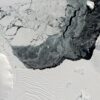Farmers and city managers across the Midwest need to know how heavy summer rains will be to plan planting, fertilizer application and floodwater management, but predicting extreme rain events is difficult, especially months to a season in advance. A new study, published today in AGU’s Geophysical Research Letters, reports how saltier ocean surface thousands of miles away are surprisingly good indicators of heavy summer rains.
Seasonal weather in the Midwest is atmospherically connected to the Pacific and Atlantic Oceans, with wind patterns delivering heat and moisture to the region at different times in the year. Scientists have long relied on sea-surface temperatures to predict how those wind patterns will behave and what the weather will be thousands of kilometers away from the ocean.
But sea surface temperature is highly variable, especially as oceans warm, so rainfall predictions based on temperature can be hit-or-miss, which isn’t helpful for farmers looking to time their planting with the rains. Adding data about surface salinity improves predictions for overall seasonal rainfall by telling meteorologists how much water has been supplied to the atmosphere.
When water evaporates from the ocean, it leaves its salt behind, so the surface ocean gets a little bit saltier. That evaporation is driven by large-scale atmospheric patterns that are connected to weather over the continental U.S., so saltiness works as an indicator for the amount of moisture carried by the atmosphere and patterns in where it will rain out.
“For these seasonal weather patterns, we look at the oceans because they store far more heat and water than the atmosphere,” and therefore drive large-scale atmospheric patterns, explained oceanographer Raymond Schmitt at Woods Hole Oceanographic Institute, a coauthor of the new study.
Remote sensing and floating sensors provide frequently updated salinity data for vast swaths of the oceans, allowing Schmitt and colleagues to draw connections between salinity and weather patterns.
“It turns out for extreme precipitation years, patterns of sea surface temperature are just really diverse, with different patterns every year,” said Laifang Li, a climate scientist at Pennsylvania State University and lead study author. “Salinity is more reliable,” she said, with more consistency in patterns during years with extreme precipitation.
The new study builds on previous work on salinity-based predictions Schmitt has done with Li. Schmitt is already working with agricultural suppliers to use the salinity-based predictions, which he says they have found helpful for advising farmers and an improvement on other predictors.
Sensing summer rains
The study specifically improves predictions of magnitude for summer extreme rainfall events in the Midwest, which are more difficult to accurately predict than overall rainfall for a season. Li used Midwest rainfall data from 1948 to 2019 and compared it to sea surface temperature and salinity records in different parts of the Pacific and Atlantic oceans across the same time period.
Li, Schmitt and colleagues found that by incorporating springtime sea surface salinity in the tropical Pacific and subtropical North Atlantic into predictive models, their predictions for summertime extreme rain events were 92% more accurate than sea surface temperature-based predictions alone for the Midwest. In practical terms, their models using salinity captured twice as much variability in the amount of extreme rains as models using sea surface temperature.
“The relationship between sea surface temperatures and tropical precipitation can be complicated, especially when we consider warming oceans. This study suggests there is a more direct connection between sea surface salinity and the tropical atmospheric processes that affect weather and climate in North America,” said Nathaniel Johnson, a research meteorologist with NOAA who was not involved in the study. “I think it’s a very provocative idea, and I like the idea of sea surface salinity as a proxy for atmospheric processes in the tropics that have important implications.”
Heavy rains and extreme rain events can cost the Midwest billions of dollars in damage and economic losses every year. The “Great Flood” of 1993, which flooded the Mississippi and Missouri Rivers and sparked Schmitt’s initial interest in salinity as a predictor, caused about $15 billion of damages alone. Those losses might have been mitigated to be less than half if the salinity-based predictors were implemented in predicting extreme rainfall one season ahead. Accurately predicting extreme rainfall could also help energy managers estimate demand for summer heating, as dry summers are more likely to be hot, and manage water in hydroelectric systems, Schmitt said.
More information:
Laifang Li et al, Skillful Long‐Lead Prediction of Summertime Heavy Rainfall in the US Midwest From Sea Surface Salinity, Geophysical Research Letters (2022). DOI: 10.1029/2022GL098554
Provided by
American Geophysical Union
Citation:
Saltier seas mean heavy summer rains for US Midwest (2022, July 7)


